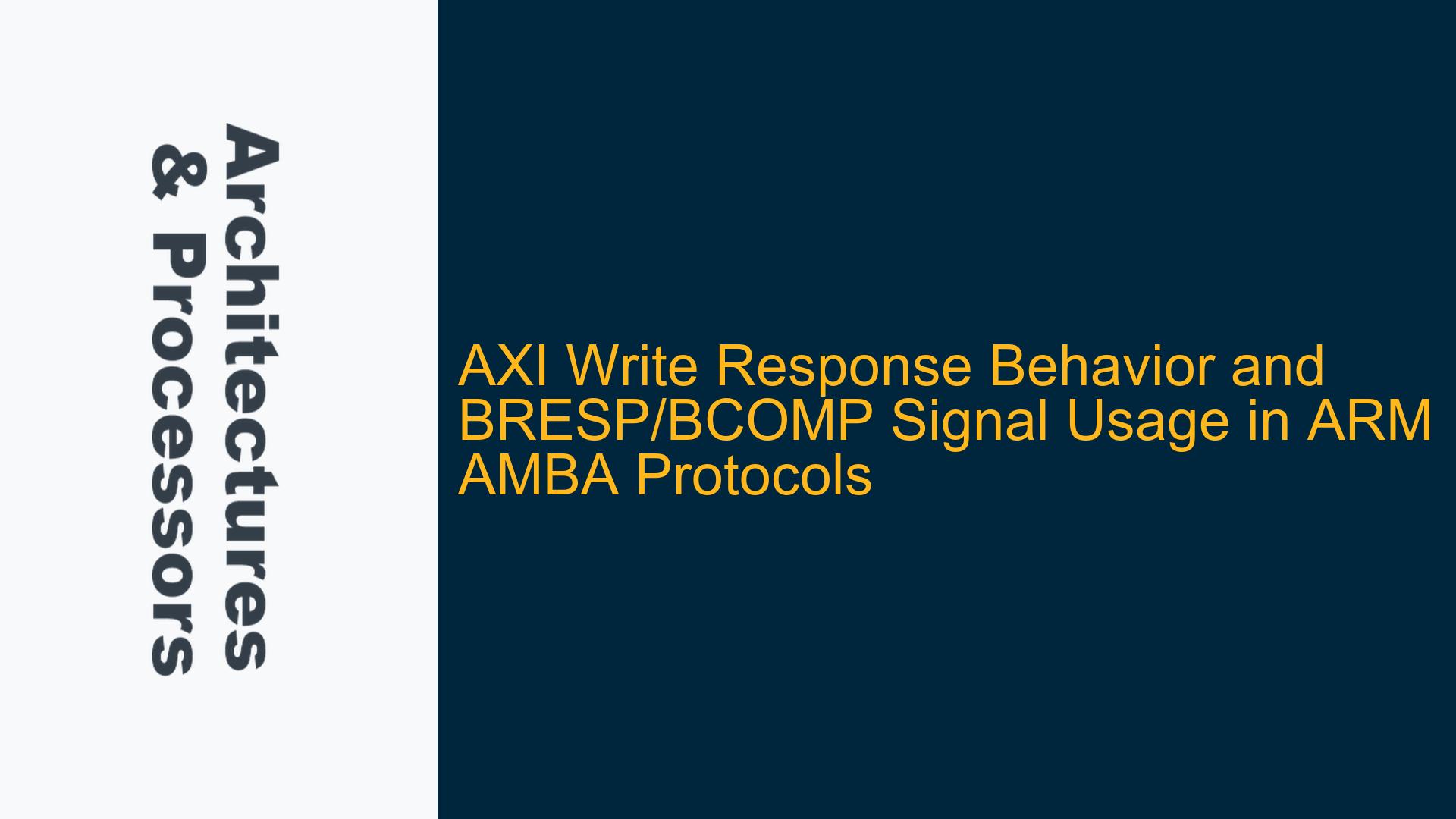Understanding AXI Write Response Requirements and Signal Behavior
The ARM AMBA AXI protocol defines a robust mechanism for write transactions, including the generation and handling of write responses. A write transaction in AXI involves the transfer of data from a manager (master) to a subordinate (slave) and requires the subordinate to acknowledge the completion of the transaction through write response signals. The AXI specification allows for one or more write responses per transaction, depending on the features enabled in the system. The primary signals involved in this process are BRESP (Write Response) and BCOMP (Write Completion).
The BRESP signal is used to indicate the status of the write transaction, such as whether it was successful (OKAY), encountered an error (SLVERR or DECERR), or requires retry (EXOKAY). The BCOMP signal, on the other hand, is used in advanced scenarios where multiple responses are required, such as in cache maintenance operations or memory tagging extensions. Understanding the behavior of these signals is critical for ensuring proper communication between the manager and subordinate in an AXI-based system.
The number of write responses generated by a subordinate depends on the specific features enabled in the system. For example, if the system supports cache maintenance operations for persistence or memory tagging extensions, the subordinate may generate two write responses per transaction. The first response indicates the status of the initial write operation, while the second response, signaled by BCOMP, indicates the completion of additional operations such as cache cleaning or memory tag validation.
BRESP Signal Optionality and Subordinate Response Requirements
The BRESP signal is optional in the AXI protocol, but its absence or presence has significant implications for both the manager and subordinate. If the BRESP signal is not present, the manager must assume that the subordinate will always respond with an OKAY status. This assumption simplifies the design of the manager but places additional constraints on the subordinate. Specifically, the subordinate must ensure that all write transactions are handled successfully and that no errors occur, as there is no mechanism to signal errors back to the manager.
When the BRESP signal is present, the subordinate is required to generate a response for every write transaction. The response must accurately reflect the status of the transaction, including any errors or retry requests. The manager, in turn, must process these responses to determine the success or failure of the transaction and take appropriate action, such as retrying the transaction or reporting an error to higher-level software.
The optionality of the BRESP signal also affects the configuration of the AXI interface. The BRESP_WIDTH property determines the width of the BRESP signal and whether it is present at all. If BRESP_WIDTH is set to 0, the BRESP signal is omitted, and the manager must assume a default OKAY response. If BRESP_WIDTH is non-zero, the BRESP signal is included, and the manager must be capable of processing the responses.
BCOMP Signal Functionality in Advanced AXI Features
The BCOMP signal plays a critical role in advanced AXI features that require multiple write responses. These features include cache maintenance operations for persistence and memory tagging extensions. In these scenarios, the BCOMP signal is used to indicate the completion of additional operations that are not covered by the initial write response.
For cache maintenance operations, the BCOMP signal indicates that the cache cleaning operation has completed and that the data is now observable in persistent memory. This is particularly important in systems where persistent memory is used, as it ensures that data is not lost in the event of a power failure or system crash. The BCOMP signal allows the manager to track the progress of cache cleaning operations and ensure that data is properly flushed to persistent memory before proceeding with subsequent operations.
In memory tagging extensions, the BCOMP signal is used to separate the match response from the completion response. Memory tagging involves associating metadata (tags) with memory locations to enable features such as memory safety and security. The match response indicates whether the tag associated with a memory location matches the expected value, while the completion response indicates that the write operation has completed successfully. The BCOMP signal allows these responses to be handled independently, enabling more efficient processing of memory tagging operations.
Troubleshooting AXI Write Response Issues and Ensuring Compliance
When designing or verifying an AXI-based system, it is essential to ensure that the write response behavior complies with the AXI specification and meets the requirements of the specific application. Common issues include incorrect handling of the BRESP signal, improper generation of multiple write responses, and misconfiguration of the BCOMP signal.
To troubleshoot these issues, start by verifying the configuration of the AXI interface, including the BRESP_WIDTH property and the presence of the BCOMP signal. Ensure that the manager and subordinate are correctly configured to handle the expected number of write responses and that the BRESP and BCOMP signals are properly connected and functioning.
Next, simulate the system to observe the behavior of the write response signals. Use a testbench to generate a variety of write transactions and verify that the subordinate generates the correct number of responses and that the manager processes them correctly. Pay particular attention to edge cases, such as transactions that result in errors or require retries, as these are often the source of compliance issues.
Finally, review the AXI specification and the documentation for any advanced features, such as cache maintenance or memory tagging, to ensure that the system is correctly implementing these features. This includes verifying that the BCOMP signal is used appropriately and that the manager and subordinate are correctly handling multiple write responses.
By following these steps, you can ensure that your AXI-based system complies with the specification and operates correctly in all scenarios. Proper handling of write responses is critical for the reliable operation of the system and for enabling advanced features such as cache maintenance and memory tagging.






